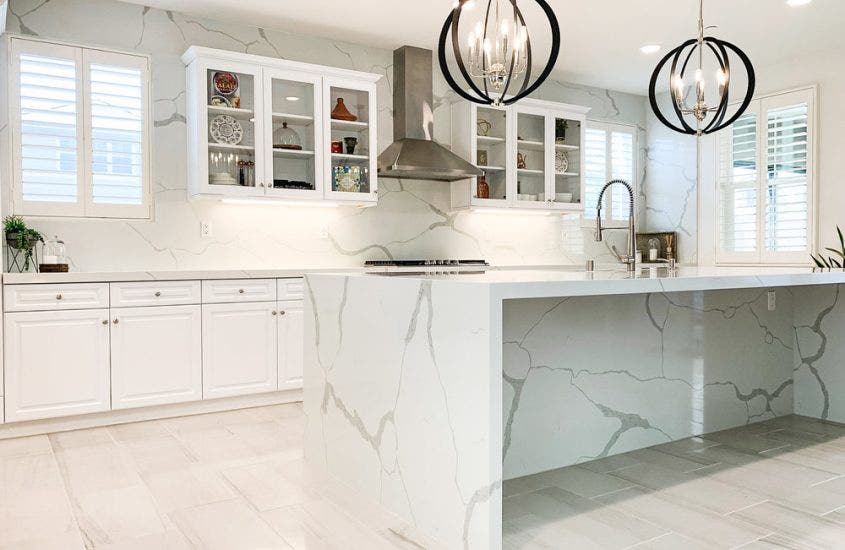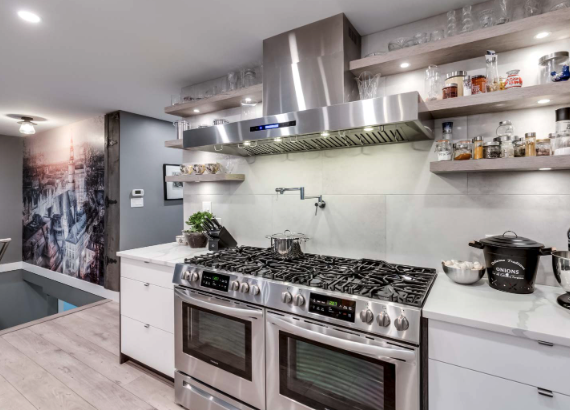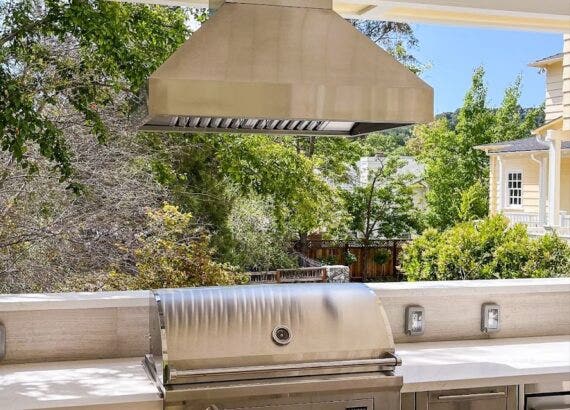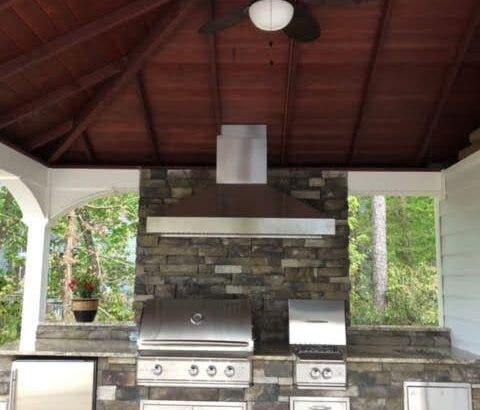How to Seal a Range Hood Vent

When installing your range hood, it’s important to ensure that all the connections are airtight. Range hoods vent cooking exhaust from your kitchen and move its air outside your home. To run at max efficiency, the air must stay inside the ductwork until it reaches the outside of your home. If your greasy kitchen air leaks back into your home, then your range hood isn’t doing its job.
If the leak is significant enough, it will feel like you don’t have a range hood at all. But, we want you to have a range hood that runs as efficiently as possible.
Here’s how to seal a range hood duct in five easy steps. Check out the short video clip below or read the step-by-step instructions for more information.
In the video above, we install a PLJW 129 wall mounted range hood. We seal the range hood vent near the end of the installation. It happens after you mount the range hood, feed the ductwork through your wall or roof, and attach the duct adaptor or transition piece. You don’t have to set up the electrical connections to the hood before this step.
But, in this video, we fed the cord through the hole with our ductwork to plug it in on the roof. Your outlet may be in a different area of your home, so be sure that the cord can reach the outlet before installation. With an extension cord, this isn’t much of an issue.
After feeding the plug through the roof, we sealed the range hood vent. Here’s how.
Table of Contents
1. Extend your duct down to attach it to the transition piece.
In the video, we use flexible ductwork for demonstration purposes. This is not recommended in your own home. Instead, use rigid ductwork. It is more durable and cost-effective than flex ductwork.
Pull the duct downward and attach it to the transition piece. You may need to stretch the duct a little so it fits comfortably.
2. Use aluminum duct tape to seal the vent.
When installing your hood, the duct might stay in place without duct tape. If not, ask a friend to hold the duct while you grab aluminum duct tape to seal the vent tight.
Or, have your aluminum duct tape ready when you attach the vent to your hood.
Apply tape to the entire outside of the range hood duct.
3. Secure the duct tape firmly to the transition piece.
If you take away anything from this article, be sure to complete this step. Even if you attach aluminum tape, it’s no good if the seal is not air tight. Use your hands to press firmly on the tape. You want to get rid of any air bubbles or gaps between the tape and the range hood duct.
4. Test the range hood before installing the chimney.
In the video, we moved on to installing the chimney after step 3. But, we’re not using our range hood to vent cooking exhaust in our own home. To save some time during the installation, plug in your hood and test the blower.
Cycle through all the different speeds and put your hand near the duct tape. Do you feel any air seeping through? If so, you need to seal it tighter or apply a second layer of tape.
If you test the range hood now, it’s easy to tell if air leaks. With a chimney covering the duct, it may be hard to notice for several weeks or even months if your range hood isn’t running at its best efficiency.
Then, once you figure that out, you have to remove the chimney to tighten the seal. So be sure to complete this step to avoid that hassle.
5. If air leaks, apply a second piece of duct tape.
If air leaks from your range hood during the test, apply a second layer of duct tape. Attach a second layer of tape a little higher than the first one. It should overlap with the top edge of your first layer of tape to secure it in place.
Or if you’re not confident in the first layer of aluminum tape, just apply a second layer. A year or two down the line, it might save you some time on repairs. There’s not a downside to adding more tape to seal the vent tightly.
How do I keep cold air from coming in my stove vent?
There are two places where your range hood duct connects: the inside of your home and the outside of your home. In the fall and winter, it gets quite cold. So, you don’t want cold air seeping through your range hood vent and into your home.
You can solve that problem with one tool: caulk. Here’s a quick video on how to caulk an exterior vent fan. This video features a bathroom fan, but the process is the same regardless of which type of fan you want to seal.
1. Remove the exterior vent from your wall.
If your current caulking is old enough, you may be able to remove the vent with your hands as in this video. If not, remove the dry caulking with a utility knife or scraper.
2. Use a utility knife or scraper to chip away at the rest of the old caulk.
Once you remove the vent, clean up any of the remaining caulk using your utility knife. One easy way to chip away at the glue is to point your utility knife toward the wall. Then, gently tap the base of the knife with a hammer.
3. Apply a generous layer of caulking glue to all the outside edges.
You can apply one to two layers of caulking – or more. It’s easy to take off the excess glue, but more difficult to add glue once the vent is already attached. So, you’re better off using too much than too little.
4. Reattach the vent to your wall.
Make sure the vent is not crooked when you reattach it to the wall. It is difficult to adjust the vent after the caulking dries.
5. Optional: Use your fingers or a paper towel to remove the excess caulking glue.
In this video, he left the caulking glue around the vent. If you want the outside of your home to look a little cleaner, you can smooth out the edges with your finger or a paper towel. Put on some latex gloves if you use your hand to cut down on the clean up later.
6. Rest a heavy object against the vent so it doesn’t fall off during the drying process.
When you rest the object against the vent, make sure it doesn’t turn the vent crooked.
7. Let the caulk dry.
Caulk takes about an hour to be dry to the touch. Leave the weight against the vent for a few days though. It may take that long for the glue to settle and become completely firm.
My range hood leaks air – what should I do?
Remove the stainless steel chimney and tighten the seal where your range hood duct connects to the hood.
Apply a second layer of aluminum duct tape to tighten the seal further.
Now, use your range hood for a few days and see if you notice a change. If not, the problem might not be that your hood is leaking air.
You might need to clean your range hood filters or replace them to keep the kitchen air moving efficiently to the outside.
Do I need a range hood damper?
A range hood damper keeps cold air, leaves, debris, and small animals from entering your ductwork from the outside. It is a vent that opens when you use your range hood and closes when you don’t. It sits inside the ductwork. For max efficiency, install it closer to the outside of your home.
For more information on backdraft dampers – or to learn if you need one for your range hood – click here.
Range Hood Vent Termination
Range hood vent termination refers to the caps that you install on your exterior wall or roof vent. If you vent through your ceiling and outside the roof, you need a roof cap. Or if you vent out an exterior wall, you need a wall cap.
These are sometimes called termination caps or termination kits.
How far can you vent a range hood?
Your range hood vent should be no longer than about 30’ of straight run, or 20’ with two elbows. For every elbow, reduce your duct run by 5’. Elbows add quite a bit of resistance, slowing down the air as it moves outside your home.
For more information on range hood ducts, check out this complete guide.
Recap
That concludes our guide on how to seal a hood vent airtight. Do you have any other questions? Feel free to call Proline Range Hoods at (877) 901 – 5530. We’re happy to assist you.
Thanks for reading!
Related Articles
How to Install a Ducted Range Hood
Can I use a semi-rigid duct for my range hood?
5 Outdoor Range Hood Installation Tips
How do I keep cold air from coming in my stove vent?
There are two places where your range hood duct connects: the inside of your home and the outside of your home. In the fall and winter, it gets quite cold. So, you don’t want cold air seeping through your range hood vent and into your home.
You can solve that problem with one tool: caulk. Here’s a quick video on how to caulk an exterior vent fan. This video features a bathroom fan, but the process is the same regardless of which type of fan you want to seal.
My range hood leaks air – what should I do?
Remove the stainless steel chimney and tighten the seal where your range hood duct connects to the hood.
Apply a second layer of aluminum duct tape to tighten the seal further.
Now, use your range hood for a few days and see if you notice a change. If not, the problem might not be that your hood is leaking air.
You might need to clean your range hood filters or replace them to keep the kitchen air moving efficiently to the outside.
Do I need a range hood damper?
A range hood damper keeps cold air, leaves, debris, and small animals from entering your ductwork from the outside. It is a vent that opens when you use your range hood and closes when you don’t. It sits inside the ductwork. For max efficiency, install it closer to the outside of your home.
For more information on backdraft dampers – or to learn if you need one for your range hood – click here.
How far can you vent a range hood?
Your range hood vent should be no longer than about 30’ of straight run, or 20’ with two elbows. For every elbow, reduce your duct run by 5’. Elbows add quite a bit of resistance, slowing down the air as it moves outside your home.
For more information on range hood ducts, check out this complete guide.







Comments are closed.